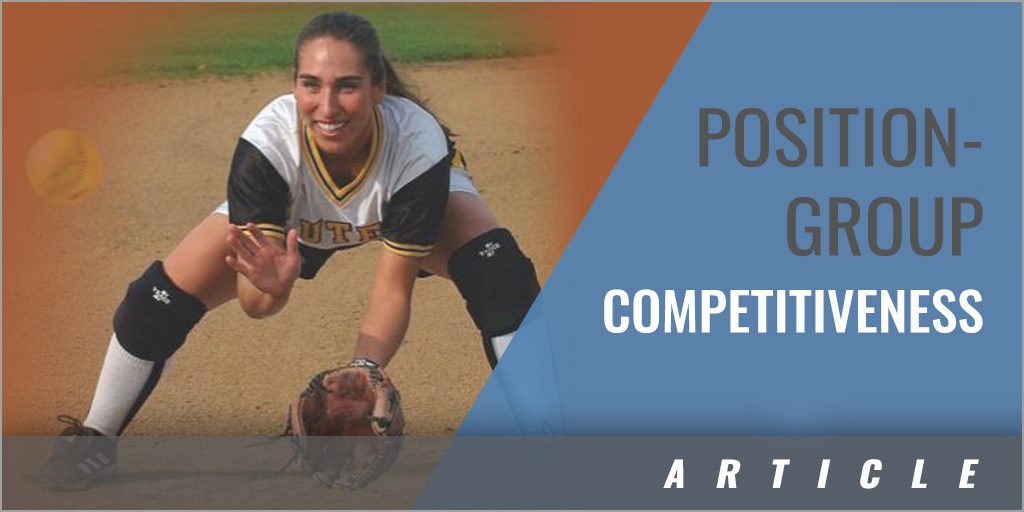|
By: Lisa (Sweeney) Van Ackeren Originally Published in: Practice Perfect Softball - NFCA Provided by: Human Kinetics Beyond skill development, position groups offer an important opportunity to help student-athletes learn how to deal appropriately with pressure situations. In my experience, a few things happen when teammates in a position group grow accustomed to competing against one another in a practice setting. First, they become desensitized to performing under pressure. We all know student-athletes who are fantastic practice players but struggle to translate their play into game situations. Coaches can implement this mental-training opportunity by creating a consistently competitive environment in practices. This type of athlete needs opportunities outside a game setting to learn how to execute. Second, they learn to embrace competition rather than fear it. In a softball world where college commitments, sport specialization, and a showcase environment have sucked the life out of young peoples' natural competitive drive, we can reignite some of that fire at practice. One of the best examples that I draw inspiration from is an assistant coach I once worked with. During infield workouts, he started by hitting warm-up reps, in order around the horn. Any time two people were taking reps at one position, our second basemen for instance, he used it as an opportunity to challenge the players there to compete in front of our team. He hit groundball after groundball to the players alternating in at that position, trying to make each round a little bit tougher, testing their range, glove skills, and footwork. The whole team stopped to watch as our second basemen went head to head, making tough play after tough play, never backing down. He hit to them back and forth until someone made a mistake, and then he moved on to hitting in order around the infield again. The best part about it was that he never said a word. You didn't know when it was coming, but when it happened, the team cheered those athletes on, pushing them to compete and challenge one another. We all loved it, secretly hoping that he would single out our position next. Here are some additional examples of how we promote competition in practices within our position groups. Pitching Staff Versus Team Have all pitchers on your staff ready to face a lineup of hitters. They can be ghost batters, athletes on the team tracking, or real hitters, depending on where you are in your season. The pitcher who starts throws the first pitch of the at-bat. The next pitcher throws the next pitch of the at-bat with the 0-1 or 1-0 count. The staff rotates through, throwing only one pitch at a time, completing an inning of batters or a game as a staff. Each pitcher learns to depend on the others to set up the group for success or to pick each other up when someone makes a mistake. This drill is a great camaraderie builder for a pitching staff because they learn how to function as a group rather than as individuals. Horse This spin on a popular basketball game can be played with many position groups. We typically use this format with hitters, slappers, and pitchers. The first person up calls her shot. It can be broad (line drive to the left side) or specific (ground ball to the second baseman). If that person succeeds, the player behind her must hit the same shot. Failing at that, she earns a letter. If a player earns enough letters to spell Horse (or the name of your school mascot), she is out of the game. We find this an upbeat and fun game to play that creates a competitive pressure situation for the hitter. It's perfect for slappers who are working on bat control and execution. Finally, we use it with our pitchers one-on-one or as a staff. Again, the focus is on execution in a pressure situation. Last Person Standing This challenge can be used for hitting or defense. For hitting, the whole team lines up, and one by one they must execute a line drive to stay in the game. If they do, they're still in and go to the back of the line. If they don't, they're out. A variation is to have players hit as many line drives in a row as they can - whoever hits the most in a row wins. You can do this on defense too. We have an infielder line in the dirt and an outfielder line in the grass. The player must field the ball cleanly and make a good throw to stay in the game. The longer the game goes on, the tougher the rounds get. By the end, everyone should be diving all over the place to stay in the game. We like this from a defensive standpoint because it breeds fearlessness. If you play not to lose, chances are you will make a mistake. We encourage our athletes to focus on the process of winning rather than the outcome. If they trust their training and mechanics, they'll be successful in this game. Partner Motivation Tapping into thoughtful pairings of athletes, one of the most interesting discussions you can have with your team is learning who on the team motivates them. Go around the whole group to let each team member identify which of her teammates motivates her at practice and why. Taking this to the next level, you can pair athletes together or have them pair themselves with teammates who motivate them. Then take them through a hitting circuit. You can do this on a normal reps day, just allowing the athletes to interact and challenge each other. You can also assign point values to stations, allowing them to compete at each station with someone who inspires them to get better. When you begin to tackle establishing a competitive environment within position groups on your team, two important things are to (1) institute routines with an athlete's approach and (2) be creative with practice structure. Setting expectations for how that position group will interact and how they will practice is essential for promoting competitiveness. The kind of routines you implement within a position group greatly enhances their ability to compete with each other and eventually with an opponent. If the coaching staff sets the expectation that position groups will challenge each other every day, they become accustomed to training in a consistently competitive environment, which promotes the growth of all members of that position group. Being creative in the structure of these practices allows your players to be exposed to different kinds of challenges that may come up in a game setting. Taking it a step further, regulating the amount of pressure the team is experiencing at practice can help team members develop competitiveness whatever the environment is around them. |







